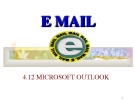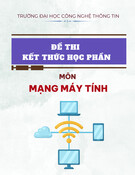
[ Team LiB ]
Creating and Editing Email
Creating and editing messages is a fairly simple task with either Word or Outlook as your
email editor.
1. Open a new message form by selecting File, New Message or select a received
message and choose Reply
2. Begin typing in the message body. The Outlook editor has simple word processing
features, whereas Word editor enables you to use all of Word's features.
3. When you're finished, click the Send button or use the keyboard shortcut, Ctrl+S.
That was easy, but you'll probably want to configure spell checking, fonts, and other
options.
Spelling has its own tab on the Tools, Options dialog (see Figure 5.6). Things to consider
when enabling the spelling options include
• Always Check Before Sending is not necessary if you use the Word editor and
enable Spell Check As You Type.
• Ignore Original Message Text in Reply or Forward fails if you reply to a plain text
message and use the option to prefix the original message.
Figure 5.6. Configure your spelling and AutoCorrect options using the Tools,
Options, Spell Check dialog.

Outlook's editor supports some AutoCorrect features, but they only work for plain text
and RTF messages, not HTML. Changes to the AutoCorrect settings in Outlook do not
affect the AutoCorrect settings in Word, enabling you to use different configurations in
each program.
Use Ctrl+Z to undo AutoCorrect's changes.
Configure the fonts used on new messages, replies, and plain text messages in Tools,
Options, Mail Format, Fonts (see Figure 5.7). You can configure these settings from a
new message form when using Word as your editor by choosing Tools, Options, General,
E-mail Options.
Figure 5.7. Choose the fonts and colors used when composing and replying to

messages. The plain text font also affects the font used in the Reading Pane.
Using Stationery
If you'd like to send a graduation or birthday wish on pretty stationery instead of a drab
white note, choose Actions, New Mail Using, More Stationery and select from the list of
installed HTML stationeries. Choosing Get More Stationery opens your Internet browser
to the Office downloads site at Microsoft.com with the currently available stationery
listed.
You aren't limited to using Microsoft stationery; in fact, many other Web sites have
prettier stationery available. You can use your favorite search engine and the keywords
outlook stationery to find these sites, including thundercloud.net.
Any stationery created for Outlook Express also works with Outlook.

You can save your downloaded stationery to the stationery folder, located at
C:\Documents and Settings\username\Application Data\Microsoft\Stationery or save it to
any folder you prefer. When it's saved to the Stationery folder, it's listed in the stationery
picker. Or you can use Insert, File to browse for the stationery and use Insert as Text.
You can create your own stationery using any HTML editor or save existing messages as
stationery using File, Save As and choosing HTML.
Sending messages with stationery can result in very large email
messages. Avoid using stationery when you email people who have a
dial-up account.
Creating HTML Messages
Many people leave Outlook configured to send HTML email, but rarely use any special
HTML formatting, even though both the Outlook editor and Word offer basic HTML
editing functionality via the Formatting toolbar (see Figure 5.8).
Figure 5.8. Use the tools on the Formatting toolbar to create simple HTML
messages.
If you want to create complicated HTML messages or stationery, you'll probably want to
use an HTML editor.
Using RTF Formatting
Rich text formatting should only be used in-house, where everyone uses Exchange Server
and Outlook because other email clients do not support it and Outlook converts RTF to
HTML when sending a message to an Internet address.

Using Outlook's editor and HTML as your default format, you first
need to switch to Format, Plain Text, and then select Rich Text, which
is also on the Format menu. The Outlook editor can't switch between
HTML and rich text.
RTF is required to use voting buttons, meeting or task requests, and to send hyperlinks to
files using the Insert command.
As with HTML, RTF supports font formatting such as different size fonts, multiple colors
of text, and background colors.
Adding Signatures to Your Email
Outlook can be configured to automatically add a block of text to your outgoing
messages. Each email account in your profile can have a different block of text, or
signature, and you can create one signature for new messages and a different one for
replies and forwards.
Task: Create a Signature
Before Outlook can add a signature to your messages, you need to create one or more
signatures and tell Outlook which signature to use and when to use it.
1. Choose Tools, Options, Mail Format tab, and then click Signatures at the bottom
of the dialog to open the Create Signature dialog, as seen in Figure 5.9.
Figure 5.9. Use the Create Signature dialog to create new signatures or edit
existing signatures.





















![Đề thi cuối kì Nhập môn Mạng máy tính: Tổng hợp [Năm]](https://cdn.tailieu.vn/images/document/thumbnail/2025/20251110/nminhthoi53@gmail.com/135x160/38281762757217.jpg)



![Đề thi học kì 2 môn Nhập môn Mạng máy tính [kèm đáp án]](https://cdn.tailieu.vn/images/document/thumbnail/2025/20251014/lakim0906/135x160/23811760416180.jpg)
